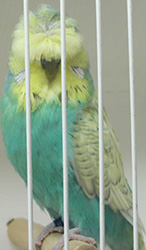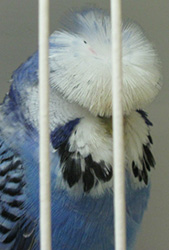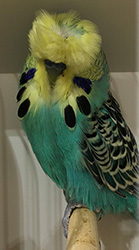by Grant Finlay

CRESTS
- Like them or hate them, there are many in both camps. They are
here to stay!
RIDICULED
Of all the `Rare Varieties' the Crest is the most ridiculed -
perhaps because of the size of the birds in general or the
feather disturbance on the head which some say spoils the shape
of the bird. However, Crest breeders are very dedicated together
with being thick skinned and it must be said that without this
dedication the Crest like many other rare varieties would have
disappeared into oblivion and this would be a tragedy not only
for this generation of bird keepers but also the generation to
follow.
RECOGNITION
Crests have been around for some 70 years but it is only in the
last 20 years or so that they have gained in popularity and
recognition of the variety was received from the BS through
separate classes being allocated at Open Shows.
LOCAL INFLUENCE
The variety is popular throughout the country and is quite
strong in the Lancs Chesshire area through the good efforts of a
small band of fanciers who have bred and exhibited Crests and
also sold their surplus stock locally and further afield in an
effort to encourage others to take up the challenge of breeding
Crests. Four members spring to mind - Ian Paton, Steve Thomas,
Dave Cottrell, Joan & John Chell who have all had excellent
success on the showbench with Crests.



TYPES OF
CRESTS
The Crested variety is made up of 3 types of Crest which are
described below:
TUFT:
This variety is similar to the cockatiel type of crest and varies
in size from a few disturbed head feathers to the preferred
strong upright tuft of 3/8".
HALF CIRCULAR or fringe type of Crest:
This usually consists of a half-ring of raised feathers around the
front of the head with the back head feathers lying flat as
normal.
CIRCULAR:
As its name
implies, the Crest goes all around the head.
BREEDING CRESTS
Breeding crests can be a complicated business! The offspring
which do not show a visual Crest may be split for Crest
(Crest-bred) or may be a normal (non-Crest) budgie. These
non-visual birds require to be test mated to establish if they
carry the crested gene as those found to be split for crest are
obviously valuable in the breeding room so therefore it can be a
long and complicated process.
BREEDING EXPECTATIONS
Any of the 3 types of Crest described above can be paired
together or paired with Crest bred or with
GREAT IMPROVEMENTS
Some of the most famous budgie breeders in the country have
taken up the challenge of breeding Crests including the great
Harry Bryan and together with other Crested fanciers have made
great improvements in the size of the Crested stock in this
country. This has resulted in many of the winners at the top
shows being the size and shape of good normal type budgies.
SPECIALIST CLUB
A specialist club caters for all Crested Breeders and Exhibitors
and is called the Crested Budgerigars Club which was formed 30
years ago and is the oldest of the specialist societies still in
existence. The club promotes the crested variety throughout the
world and has approximately 100 members worldwide with the
majority in the
